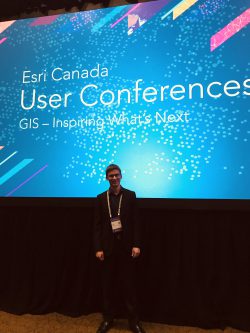COG(S)itation on the Esri Canada Fredericton User Conference 2018
Greetings everyone,
My name is Liam Gowan and I am enrolled in the Advanced Diploma in Geographic Sciences (and will be enrolling in the GIS concentration) at the Centre of Geographic Sciences, NSCC. I am one of the six ECCE Student Associates from COGS, and I am writing to reflect on my experience of the conference, and hope that this post will help you get a sense of what Esri User Conferences are like.
This was my first conference, so I wasn’t sure what to expect, though I was pleasantly surprised to find the seminars informative (from those employed by Esri Canada, and those using Esri products, such as a Dalhousie Ph.D student who used the products to track 4000 trees for urban forest management), the vendors to be a wealth of inspiration towards what one can do with GIS, and the overall collection of people (Esri Canada staff, exhibitors, vendors, potential employers and students) to be a goldmine for networking.
On day 1 of 2, attendees gathered for the Plenary sessions, where we learned about the following three main topics:
- The latest and greatest additions that Esri has released to the public, such as:
- Collaboration Features – Allows multiple departments or organizations to easily share data, content and a digital workspace.
- 3D building features (within the 3D Analyst toolbox) including Line of Sight, which allows physical security employees to visualize where cameras can and cannot record.
- Operations Dashboard – A unique way of visualizing various attributes, such as the storm status in Lethbridge, and crime stats within Vancouver for the last 8 weeks (and compared to the corresponding 8 weeks of the previous year), allowing users to make informed decisions.
- Existing features that non-GIS professionals may not be aware of, including:
- Customized Basemaps – The existing Basemaps by Esri may not represent or be appropriate for a given organizations specific needs, so they can be customized accordingly. Customizable features include colours and symbology, the toggling of certain layers, language settings and disputed boundary representation.
- Survey123 – A form-centric form of data collection that uses logic to “ask the right questions” and works with other systems within an organization.
- Collector – At first glance this appears to be similar to Survey123, but it’s capabilities are different. Collector is an app for fieldworkers to go into the field and quickly obtain geographic points and important information (such as the status of a light pole), thus saving both time and paper.
- And finally, some things that we can expect from Esri in the near future are:
- ArcGIS Indoors – A work in progress that will allow organizations to map and understand assets and employees (and their devices) from within the organization’s buildings. ArcGIS Indoors promises to evaluate security vulnerabilities, the efficiency of space allocation, and more.
- Location Tracking – Turns employees into sensors, to monitor both efficiency (such as delivery trucks) and safety (such as preventing people from heading towards hazards). Will be able to either be turned on and off or have a schedule, and will be able to record information while offline. Recorded attributes will include location, altitude, speed, activity, battery life, and distance travelled.
- Survey123 – While currently only allows geographic points to be entered, in the future they hope to allow collection for lines and polygons as well. Also, extended GNSS external receiver support will be coming soon.
On the second day, attendees went to their choice of various Esri-led technical sessions and user presentations. Below are examples of two technical sessions that I went to.
Arcade: It’s not just for labels presented by Lauren Wilson, Technical Solutions Specialist.
During this session, Lauren explained how Arcade is an expression scripting language that is used to quickly do math, manipulate text, and transform data, to create a fully customized end product. In addition to customizing labels, Arcade can be used for predominance variation and transparency, customization for pop-up menus, charts and symbology. Arcade can also be used easily with HTML to show certain attributes. Esri provides very good documentation for all functions in Arcade.
Survey123 Deep Dive presented by Sue Enyedy-Goldner, Technical Solutions Specialist.
During this “deep dive”, Sue went over what Survey123 is, how its used for form-centric data collection, and how to make the forms. As mentioned previously, Survey123 allows users to enter data through forms, known as smart forms. The way in which one question is answered may affect whether or not certain other questions are asked. The resulting data from Survey123 can easily be put into an Excel spreadsheet, and results may be analyzed immediately with already existing data (which can be edited if required). Sue showed how it is easy to make the forms using 18 different questions types (multiple choice, fill in the blank, date, etc.). Questions can also be grouped together, and groups of questions can be asked repeatedly if required.
The conference included plenty of time to check out products by other companies and speak with their representatives. Also included were refreshments between talks, dinner, and live entertainment.
As a student, I would personally recommend going to an Esri Conference to anyone looking to get started in the industry.

